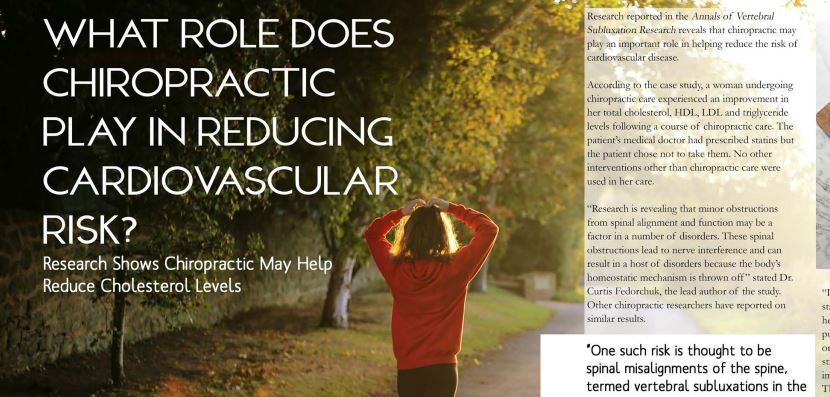What Role Does Chiropractic Play in Reducing Cardiovascular Risk?
Research Shows Chiropractic May Help Reduce Cholesterol Levels
Coherence Through Chiropractic, Volume 21, Issue 1
Research reported in the Annals of Vertebral Subluxation Research reveals that chiropractic care may play an important role in helping reduce the risk of cardiovascular disease.
According to the case study, a woman undergoing chiropractic care experience an improvement in her total cholesterol, HDL, LDL and triglyceride levels following a course of chiropractic care. The patient’s medical doctor had prescribed statins but the patient chose not to take them. No other interventions other than chiropractic care were used in her case.
“Research is revealing that minor obstructions from spinal alignment and function may be a factor in a number of disorders. These spinal obstructions lead to nerve interference and can result in a host of disorders because the body’s homeostatic mechanism is thrown off” stated Dr. Curtis Fedorchuk, the lead author of the study. Other chiropractic researchers have reported on similar results.
“One such risk is though to be spinal misalignments of the spine, termed vertebral subluxations in the scientific literature, which result in structural and neurological obstruction to the nerve system. It is this obstruction that may cause a cascade of neuroendocrine events that lead to abnormal cholesterol metabolism. The theory is that once those spinal distortions are corrected the body is better able to balance its physiology.”
“It makes a lot of sense when you think about it” stated Dr. Matthew McCoy a chiropractor, public health researcher and editor of the journal that published the study, “If you damage or compress or otherwise interfere with the neurological structures in the spine this can have far reaching implications on the functioning of the body. Through research reports like Fedorchuk’s we are finding that correcting the misalignments associated with these spinal problems reduces the nerve obstruction and people experience improvement. In this study it was a woman who had risk factors for cardiovascular disease.”
Once diagnosed, traditional medical treatment for increased cholesterol levels usually involves a prescription for statins. While statins have been shown to reduce cholesterol levels they come with serious side effects and have not been shown to prolong life. What has been shown to reduce and prevent cardiovascular disease and death are lifestyle changes.
“Finding the cause of the cardiovascular disease and reducing those risks is a much better strategy” according to McCoy. One such risk is thought to be spinal misalignments of the spine, termed vertebral subluxations in the scientific literature, which result in structural and neurological obstruction to the nerve system. It is this obstruction that may cause a cascade of neuroendocrine events that lead to abnormal cholesterol metabolism. The theory is that once those spinal distortions are corrected the body is better able to balance its physiology.
The 49 year old woman in the study had several musculoskeletal complaints and reported a reduced quality of life along with her cardiovascular risk factors. She had recently seen a medical doctor who had prescribed statins in an effort to lower her cholesterol but she did not want to take them and elected not to.
The chiropractor diagnosed her with vertebral subluxations and an abnormal spinal curve in her neck and adjusted her spine. Follow-up laboratory work revealed that her cholesterol, HDL, LDL and triglycerides had all improved, she reported an improvement in mental and physical health and her musculoskeletal complaints had resolved. The authors call for further study in a controlled environment.
Reference:
Curtis Fedorchuk DC, Jill Leeder Burk DC, Sean Phillips DC. Reduction in Cholesterol and Improved Quality of Life in a Patient with Dyslipidemia Undergoing Chiropractic Care: A Case Study. Annals of Vertebral Subluxation Research. June 2, 2011. Pages 26-36
Vertebralsubluxationresearch.com, Coherence Through Chiropractic, Vol. 21, Issue 1


